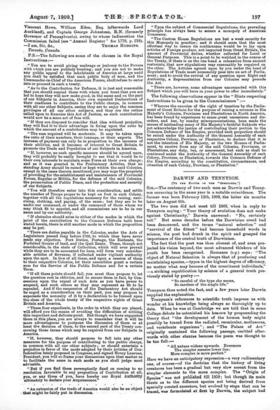DARWIN AND TENNYSON. rio TB. EDITOR or Tull "SPROTATOR.1 SIR, — The
centenary of two such men as Darwin and Tenny- son occurring in the same year is a notable coincidence. The former was born February 12th, 1809, the latter six months later on August 6th.
The two men did not meet till 1868; when in reply to Tennyson saying : "Your theory of evolution does not make against Christianity," Darwin answered : "No, certainly not." But some decades before the Darwinian creed had been denounced, and the terms "natural selection" and "survival of the fittest" had become household words in science, the poet had drunk in the spirit and grasped the importance of the central truth of Darwinism.
The fact that the poet was thus abreast of, and even pro- jected his vision beyond, the most advanced thinkers of his youth has been recognised. Romans (e.g.) says: " The object of Natural Selection is always that of producing and maintaining species,—types in the highest degree of efficiency, no matter what may become of the constituent individuals," —a striking republication by science of a general truth pre- viously stated by poetry r-
" So careful of the type she seems, So careless of the single life."
Tennyson thus noted the fact, and a few years later Darwin supplied the explanation.
Tennyson's references to scientific truth impress us with
wonder at his knowledge being always so thoroughly up to date. When he was at Cambridge we are told that in some College debate he astonished his hearers by propounding the theory that " the development of the human body might possibly be traced from the radiated, vermicular, molluscous, and vertebrate organisms"; and "The Palace of Art" originally contained the following passage, omitted after- wards with other stanzas because the poem was thought to be too full :—
" All nature widens upwards. Evermore The simpler essence lower lies: More complex is more perfect."
Here we have an anticipatory expression—a very rudimentary one, of course—of the doctrine that the history of living creatures has been a gradual but very slow ascent from the simpler elements to the more complex. The "Origin of Species" was not published till 1859; but though its main
thesis as to the different species not being derived from specially created ancestors, but evolved by steps that can be traced, was formulated at first by Darwin, the subject had been for some time, so to speak, in the air. There had been tentative approaches to the solution of the problem, made by the early " transmutationista," as they were then called, such as Lamarck. which did not, however, satisfy the naturalists of the time. Light is thus thrown on the genesis of such a passage as :— "They say, The solid earth whereon we tread
In tracts of fluent heat began,
And grew to seeming-random forms, The seeming prey of cyclic storms, Till at the last arose the man.
Move upward, working out the beast, And let the ape and tiger die."
Yet this was published nine years before Darwin's epoch- making volume appeared, and its composition probably goes back to a much earlier date. But the precise source of this remarkable forecast and anticipation has not, to the present. writer's knowledge, been pointed out. We know that in 1837 Tennyson was deeply engaged in the study of Lyell's " Principles of Geology " (1830-33). Now chap. 33 deals very fully with Latnarck's theory of the transformation of the orang-utan into the human species.
It is not without interest to set beside those earlier utterances the lines "By an Evolutionist" published in 1889, three years before Tennyson's death :- " I have climb'd to the snows of Age, and I gaze at a field in the Past,
Where I sank with the body at times in the sloughs of a low desire.
But I hear no yelp of the beast, and the Man is quiet at last As he stands on the heights of his life with a glimpse of a height that is higher."
In his notes in the Evereley Edition Lord Tennyson says : "My father brought ' Evolution' into Poetry. Ever since his Cambridge days he believed in it."—I am, Sir, &c.,
FRANCIS ST. JOHN THACIIERAY.
Mapledurham Vicarage.







































 Previous page
Previous page